Toshiba 32D3453DB Instruction manual
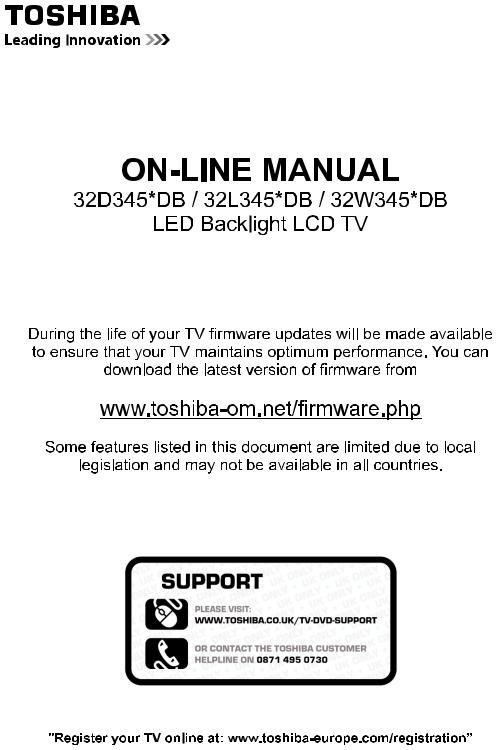

English
Get started with Freeview
Freeview gives you over 50 TV channels to play with, not to mention 25 radio stations.
Start watching all your favourite TV content today, just connect your aerial and tune in.
Keep up-to-date
New channels are launched on Freeview from time to time along with other updates to the service. So it pays to retune your digital TV periodically to make sure your Digital TV/Radio channels are up to date. To retune your Toshiba Digital TV, please refer to the Re-tune section for guidance.
Alternatively ind out more on the dedicated Freeview website:
www.freeview.co.uk/retune
Freeview service is subject to availability. Aerial upgrade may be required.
English - 1 -

English
Contents |
|
Safety Precautions ................................................. |
4 |
Air Circulation ..................................................... |
4 |
Heat Damage...................................................... |
4 |
Mains Supply ...................................................... |
4 |
Warning .............................................................. |
4 |
Do ....................................................................... |
4 |
Do not ................................................................. |
4 |
Installation and Important Information .................... |
5 |
EXCLUSION CLAUSE........................................ |
5 |
Important safety information................................... |
6 |
Removing the pedestal stand................................. |
7 |
The Remote Control ............................................... |
8 |
Inserting Batteries and Effective Range of the |
|
Remote Control................................................... |
8 |
Connecting External Equipment............................. |
9 |
Connecting an HDMI® or DVI Device to the HDMI |
|
Input...................................................................... |
10 |
To Connect an HDMI Device ............................ |
10 |
To Connect a DVI Device.................................. |
10 |
To Connect a Computer..................................... |
11 |
Connecting a DVD Player...................................... |
11 |
Connecting to a DVD Player via YPbPr............. |
11 |
Connecting a USB Memory................................... |
11 |
To Connect a USB Flash Drive.......................... |
11 |
Connecting a Computer......................................... |
11 |
Connecting a home network................................. |
12 |
Power Save Mode ................................................ |
13 |
Environmental Information ............................... |
13 |
Controlling the TV................................................. |
14 |
Switching on ..................................................... |
14 |
Using the Remote Control ................................ |
14 |
Using the Controls on the TV............................ |
14 |
Initial Installation .................................................. |
15 |
Auto Tuning .......................................................... |
17 |
Auto Tuning....................................................... |
17 |
Manual Tuning, Analogue Fine Tuning ................. |
18 |
Digital Aerial Manual Search............................. |
18 |
Digital Cable Manual Search ............................ |
18 |
Analogue Manual Search ................................. |
18 |
Analogue Fine Tune.......................................... |
18 |
Clear Service List (*)......................................... |
18 |
General Operation................................................ |
19 |
Stereo and Bilingual Transmissions.................. |
19 |
Displaying Subtitles .......................................... |
19 |
Viewing Main Menu .......................................... |
19 |
Controlling Volume and Muting Sound ............. |
19 |
Selecting Programme Positions........................ |
19 |
Standby Notiications........................................ |
19 |
Channel List, Sorting Programmes, Programme |
|
Locking ................................................................. |
20 |
Viewing Channel List ........................................ |
20 |
Moving a Channel............................................. |
20 |
Deleting a Channel ........................................... |
20 |
Renaming a Channel........................................ |
20 |
Locking a Channel............................................ |
20 |
Viewing Info Banner, Electronic Programme |
|
Guide.................................................................... |
21 |
Viewing Info Banner.......................................... |
21 |
Electronic Programme Guide............................ |
21 |
Language Selection.............................................. |
22 |
Language Settings............................................ |
22 |
Preferred....................................................... |
22 |
Current.......................................................... |
22 |
Digital Settings - Parental Control, Menu Lock, Set |
|
PIN........................................................................ |
23 |
Viewing Parental Control Menu ........................ |
23 |
Menu Lock ........................................................ |
23 |
Maturity Lock (*)................................................ |
23 |
Child Lock......................................................... |
23 |
Set PIN ............................................................. |
23 |
Coniguring Picture Settings ................................. |
24 |
ConiguringPictureSettings ............................. |
24 |
Mode................................................................. |
24 |
Contrast ............................................................ |
24 |
Brightness......................................................... |
24 |
Sharpness......................................................... |
24 |
Colour ............................................................... |
24 |
Power Save Mode ............................................ |
24 |
Backlight ........................................................... |
24 |
Noise Reduction ............................................... |
24 |
Advanced Settings........................................ |
24 |
Reset ................................................................ |
25 |
Changing Picture Format...................................... |
26 |
Coniguring PC Picture Settings........................... |
27 |
PC Picture Settings (*)...................................... |
27 |
PC Position....................................................... |
27 |
Autoposition...................................................... |
27 |
H Position ......................................................... |
27 |
V Position.......................................................... |
27 |
Dot Clock .......................................................... |
27 |
Phase................................................................ |
27 |
Coniguring Sound Settings .................................. |
28 |
ConiguringSoundSettings .............................. |
28 |
Operating Sound Settings Menu Items............. |
28 |
Volume.............................................................. |
28 |
Equalizer (Only for speaker)............................. |
28 |
Balance (Only for speaker)............................... |
28 |
Headphone ....................................................... |
28 |
Sound Mode ..................................................... |
28 |
AVL ................................................................... |
28 |
Headphone/Lineout .......................................... |
28 |
Dynamic Bass................................................... |
28 |
Surround Sound................................................ |
28 |
Digital Out......................................................... |
28 |
Settings Menu Operation, Conditional Access ..... |
29 |
Coniguring Your TV’s Settings ......................... |
29 |
Viewing Settings Menu ..................................... |
29 |
Conditional Access ........................................... |
29 |
English - 2 -

Language.......................................................... |
29 |
Parental ............................................................ |
29 |
Timers............................................................... |
29 |
Date/Time ......................................................... |
29 |
Sources............................................................. |
29 |
Network Settings............................................... |
29 |
Other Settings................................................... |
29 |
Netlix................................................................ |
29 |
Using a Conditional Access Module ................. |
29 |
Setting Timers, Setting Date/Time........................ |
30 |
Timers............................................................... |
30 |
Setting Sleep Timer .......................................... |
30 |
Setting Programme Timers............................... |
30 |
ConiguringDate/TimeSettings ........................ |
30 |
Source Settings, Other Controls........................... |
31 |
ConiguringSourceSettings ............................. |
31 |
Input Selection.................................................. |
31 |
ConiguringOtherSettings-General ............... |
31 |
Operation.......................................................... |
31 |
Menu Timeout................................................... |
31 |
Scan Encrypted Channels ............................... |
31 |
Blue Background .............................................. |
32 |
Software Upgrade............................................. |
32 |
Application Version ........................................... |
32 |
Hard of Hearing ................................................ |
32 |
Audio Description.............................................. |
32 |
Auto TV Off ....................................................... |
32 |
Store Mode ....................................................... |
32 |
MEDIA Renderer............................................... |
32 |
Power Up Mode................................................ |
32 |
CEC .................................................................. |
33 |
CEC Auto Power On......................................... |
33 |
Network Settings, Portal, Internet Browser and |
|
YouTube ............................................................... |
34 |
Coniguring Network Settings ........................... |
34 |
First enter to Toshiba Portal.............................. |
34 |
Using the Toshiba Portal................................... |
34 |
Using the Internet Browser ............................... |
34 |
Using YouTubeTM ............................................. |
35 |
Using Media Browser ........................................... |
36 |
Manual Start ..................................................... |
36 |
Auto Start.......................................................... |
36 |
Playing MP3 Files............................................. |
37 |
Viewing JPEG Files .......................................... |
37 |
Slideshow Feature............................................ |
38 |
Video Playback................................................. |
38 |
Media Browser Settings.................................... |
39 |
Using MENU button in Media Browser Mode ... |
39 |
To Close the Media Player................................ |
39 |
Analogue Only Text Services................................ |
40 |
Using Text Button -TEXT .................................. |
40 |
Accessing Sub-pages....................................... |
40 |
Revealing Concealed Text................................ |
40 |
Holding a Page ................................................. |
40 |
To display an initial page................................... |
40 |
“Pages 41 to 46” apply to Models with DVD loader |
|
only. ..................................................................... |
41 |
DVD Mode............................................................ |
41 |
Handling Discs.................................................. |
41 |
Cleaning Discs.................................................. |
41 |
DVD - Features................................................ |
41 |
DVD - Control buttons on the TV...................... |
41 |
How to watch a DVD......................................... |
43 |
Notes on DVD Playback ................................... |
43 |
DVD Mode Coniguration .................................. |
44 |
TV Type......................................................... |
44 |
Language Setup ........................................... |
44 |
OSD LANG ................................................... |
44 |
AUDIO .......................................................... |
44 |
DISC MENU.................................................. |
44 |
SUBTITLE..................................................... |
44 |
DEFAULT...................................................... |
44 |
DOWNMIX .................................................... |
44 |
SURROUND ................................................. |
44 |
STEREO ....................................................... |
44 |
PARENTAL.................................................... |
44 |
PASSWORD ................................................. |
44 |
SPDIF OUTPUT............................................ |
44 |
The DVD picture quality is poor........................ |
45 |
AppendixA:DVDModeSupportedileformats .... 46 |
|
AppendixB:Compatibledisctypes ...................... |
46 |
AppendixC:PCInputTypicalDisplayModes ...... |
47 |
Appendix D: AV and HDMI Signal Compatibility |
|
(Input Signal Types).............................................. |
48 |
AppendixE:PINInformation ............................... |
49 |
Appendix F: Supported File Formats for USB |
|
Mode..................................................................... |
50 |
Supported File Formats for USB Mode ................ |
50 |
Re-tune Section.................................................... |
51 |
Re-tuning:TOSHIBAFreeviewProducts .............. |
51 |
SpeciicationsandAccessories ............................ |
52 |
License Information .............................................. |
53 |
Q & A Section ....................................................... |
54 |
Warranty Card ...................................................... |
56 |
Warranty Card ...................................................... |
57 |
Warranty Card ...................................................... |
58 |
English
English - 3 -
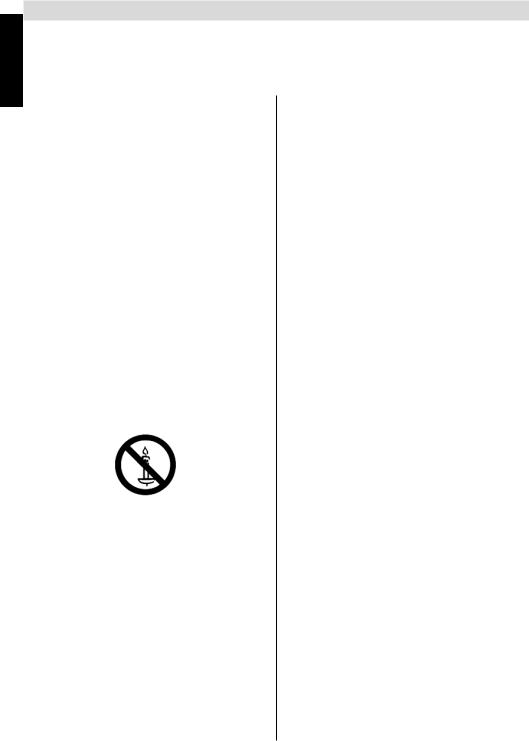
English
Safety Precautions
This equipment has been designed and manufactured to meet international safety standards but, like any electrical equipment, care must be taken to obtain the best results and for safety to be assured. Please read the points below for your own safety. They are of a general nature, intended to help with all electronic consumer products and some points may not apply to the goods you have just purchased.
Air Circulation |
|
|
Do not |
||
Leave more than 10cm around all edges when wall mounting |
|
DON’T remove any ixed cover as this may expose danger- |
|||
the television to allow adequate ventilation. This will prevent |
|
ous voltages. |
|||
overheating and possible damage to the television. Dusty |
|
DON’T obstruct the ventilation openings of the equipment |
|||
places should also be avoided. |
|
||||
|
with items such as newspapers, tablecloths, curtains, etc. |
||||
|
|
|
|
||
|
|
|
|
Overheating will cause damage and shorten the life of the |
|
|
|
|
|
equipment. |
|
Heat Damage |
|
|
|||
|
|
|
|||
Damage may occur if the television is left in direct sunlight |
|
DON’T allow electrical equipment to be exposed to dripping |
|||
|
or splashing or objects illed with liquids, such as vases, to |
||||
or near a heater. Avoid places subject to extremely high |
|
||||
|
be placed on the equipment. |
||||
temperatures or humidity, or locations where the temperature |
|
||||
|
DON’T place hot objects or naked lame sources, such as |
||||
is likely to fall below 5°C (41°F). |
|
||||
|
|
|
|
lighted candles or nightlights on, or close to equipment. High |
|
|
|
|
|
temperatures can melt plastic and lead to ires. |
|
Mains Supply |
|
|
DON’T use makeshift stands and NEVER ix with wood |
||
The set should be operated only from a 220-240 V AC 50 Hz |
|
screws. Use the stand manufacturers supplied screws. |
|||
|
|
||||
outlet. DO ensure that the television is not standing on the |
|
DON’T leave equipment switched on when it is unattended, |
|||
mains lead. DO NOT cut off the mains plug from this equip- |
|
unless it is speciically stated that it is designed for unat- |
|||
ment, this incorporates a special Radio Interference Filter, the |
|
tended operation or has a standby mode. Switch off by |
|||
removal of which will impair its performance. In the UK, the |
|
withdrawing the plug, make sure your family know how to do |
|||
fuse itted in this plug is approved by ASTA or BSI to BS1362. |
|
this. Special arrangements may need to be made for people |
|||
It should only be replaced by a correctly rated and approved |
|
with disabilities. |
|||
type. IF IN DOUBT PLEASE CONSULT A COMPETENT |
|
DON’T continue to operate the equipment if you are in any |
|||
ELECTRICIAN. |
|
||||
|
doubt about it working normally, or it is damaged in any way - |
||||
|
|
|
|
||
Warning |
|
|
|||
|
|
switch off, withdraw the mains plug and consult your dealer. |
|||
To prevent the spread of ire, keep candles or other open WARNING - excessive sound pressure from earphones or |
|||||
lames away from this product at all times. |
headphones can cause hearing loss. |
||||
|
|||||
|
|
|
|
ABOVE ALL - NEVER let anyone, especially children, |
|
|
|
|
|
push or hit the screen, push anything into holes, slots |
|
|
|
|
|
or any other openings in the case. |
|
|
|
|
|
NEVER guess or take chances with electrical equipment |
|
|
|
|
|
of any kind - it is better to be safe than sorry. |
|
|
|
|
|
THE MAINS PLUG IS USED AS A DISCONNECTING |
|
|
|
|
|
DEVICE AND THEREFORE SHOULD BE READILY OP- |
|
|
|
|
|
ERABLE. |
|
Do |
|
|
|
||
|
|
||||
DO read these operating instructions before you attempt to |
Note : Interactive video games that involve shooting |
||||
use the equipment. |
|||||
|
|||||
DO ensure that all electrical connections (including the mains |
a “gun” type of joystick at the on-screen target may |
||||
not work with this TV. |
|||||
plug, extension leads and interconnections between pieces |
|||||
|
|||||
of equipment) are properly made and in accordance with |
|
||||
the manufacturers’ instructions. Switch off and withdraw the |
|
||||
mains plug before making or changing connections. |
|
||||
DO consult your dealer if you are ever in doubt about the |
|
||||
installation, operation or safety of your equipment. |
|
||||
DO be careful with any glass panels or doors on equipment. |
|
||||
English - 4 -
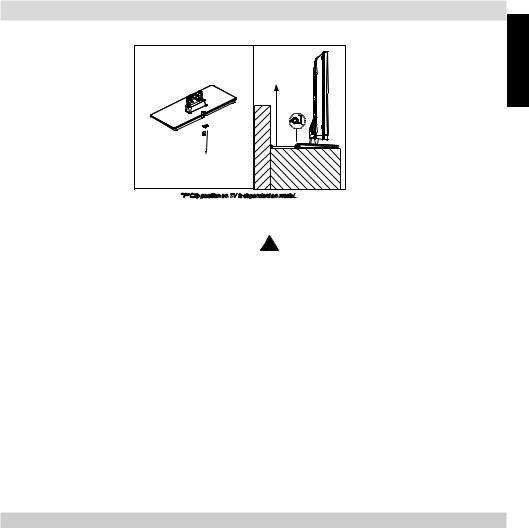
Installation and Important Information
Where to install
Sturdy tie
(as short as possible)
P Clip
P Clip
“P” Clip position on TV is dependent on model.
English
* Button and stand style is dependent on model.
Locate the television away from direct sunlight and strong lights. Soft, indirect lighting is recommended for comfortable viewing. Use curtains or blinds to prevent direct sunlight falling on the screen.
Place the TV on a stable, level surface that can support the weight of the TV. In order to maintain stability and prevent it falling over, its recommended to secure the TV to a wall using a sturdy tie on the back of the stand.
The LCD display panels are manufactured using an extremely high level of precision technology; however, sometimes some parts of the screen may be missing picture elements or have luminous spots. This is not a sign of a malfunction. Make sure the television is located in a position where it cannot be pushed or hit by objects, as pressure will break
or damage the screen. Also, please ensure that small items are not inserted into slots or openings in the case.
Avoid using chemicals (such as air refreshers, cleaning  agents, etc.) on or near the TV pedestal. Studies indicate that plastics may weaken and crack over time from the combination effects of chemical agents and mechanical
agents, etc.) on or near the TV pedestal. Studies indicate that plastics may weaken and crack over time from the combination effects of chemical agents and mechanical
stress (such as weight of TV). Failure to follow these instructions could result in serious injury and/or permanent damage to TV and TV pedestal.
Cleaning the screen and cabinet…
Turn off the power, and clean the screen and cabinet with a soft, dry cloth. We recommend that you do not use any proprietary polishes or solvents on the screen or cabinet as this may cause damage.
Please take note
The digital reception function of this television is only effective in the countries listed in the “Country” section during the irst time installation menu. Depending on country/area, some of this television’s functions may not be available. Reception of future additional or modiied services cannot be guaranteed with this television.
If stationary images generated by 4:3 broadcasts, text services, channel identiication logos, computer displays, video games, on screen menus, etc. are left on the television screen for any length of time, they could become conspicuous. It is always advisable to reduce both the brightness and contrast settings.
Very long, continuous use of the 4:3 picture on a 16:9 screen may result in some retention of the image at the 4:3 outlines. This is not a defect of the LCD TV and is not covered under the manufacturer’s warranty.
Regular use of other size modes will prevent permanent retention.
EXCLUSION CLAUSE
Toshiba shall under no circumstances be liable for loss and/or damage to the product caused by:
i)ire;
ii)earthquake;
iii)accidental damage;
iv)intentional misuse of the product;
v)use of the product in improper conditions;
vi)loss and/or damage caused to the product whilst in the possession of a third party;
vii)any damage or loss caused as a result of the owner’s failure and/or neglect to follow the instructions set out in the owner’s manual;
viii)any loss or damage caused directly as a result of misuse or malfunction of the product when used simultaneously with associated equipment;
Furthermore, under no circumstances shall Toshiba be liable for any consequential loss and/or damage including but not limited to the following, loss of proit, interruption of business, the loss of recorded data whether caused during normal opera-
tion or misuse of the product.
English - 5 -

Important safety information
English |
• Any function related to the digital television (with the DVB logo) is available only within the country or area |
|
where such signals are transmitted. Verify with the salesperson if it is possible to receive a DVB - T/C signal |
||
|
||
|
in the area where you live. |
|
|
• Even if the television conforms to the required DVB - T/C speciications, the compatibility with future digital |
|
|
DVB - T/C transmissions is not guaranteed. |
|
|
• Some digital television functions may not be available in certain countries. |
|
|
• The DVB - T/C system present in this device, allows reception of both FTA (Free To Air) and Encrypted |
|
|
channels. |
|
|
Note; Encrypted channels require a speciic encryption system to view, which may not be available in certain |
|
|
countries. |
|
|
• DVB is a registered trademark of the DVB Project. This logo indicates that the product is compliant with |
|
|
European Digital Broadcasting. |
|
|
IMPORTANT INFORMATION |
TV Installation
•Do not stand the televisions on cloth or other materials placed between the television and supporting furniture.
•Educating children about the dangers of climbing on furniture to reach the television or its controls.
•Always hold the plug when disconnecting the unit from the socket outlet. Do not pull on lex. The lex can become damaged and cause a short circuit.
•Use a soft, dry cloth to clean the unit.
•Set up unit so that no one will trip over the lex.
•If you intend to wall mount the unit, contact the shop where you purchased the unit for advice, and leave the installation work to professionals. Improper installation can cause damage and/or injuries.
•To protect the unit during a thunder storm, unplug the AC power cord and disconnect the aerial, cable and satellite decoder/systems etc.
Caution: Do not touch the aerial connector.
• The unit becomes warm when in operation. Do not place any covers or blankets on the unit in order to prevent overheating.
The ventilation holes should not be blocked. Do not set up near radiators. Do not place in direct sunshine.
• Moisture condensation occurs in the following situations:
-When you move the unit from a cold place to a warm place.
-When you use the unit in a room where the heater was just turned on.
-When you use the unit in an area where cold air from an air conditioner directly hits the unit.
-When you use the unit in a humid place.
•Never use the unit when moisture condensation could occur.
•Using the unit when moisture condensation exists may damage its own internal parts. After two or three hours, the unit will warm up and moisture will be evaporated.
English - 6 -
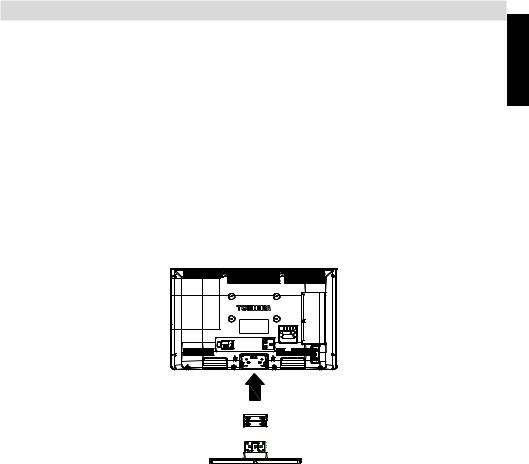
Removing the pedestal stand
When using a Wall Bracket
Please use a wall bracket appropriate for the size and weight of the LCD TV.
•Two people are required for installation.
•To install a wall-mount;
(1)Unplug and remove any cables and/or other component connectors from the rear of the TV.
(2)Carefully lay the front of the unit face down on a lat, cushioned surface such as a quilt or blanket.
(3)Follow the instructions provided with your wall bracket. Before proceeding, make sure the appropriate bracket(s) are attached to the wall and the back of the TV as described in the instructions provided with the wall bracket.
(4)Always use the screws supplied or recommended by the wall mount manufacturer.
Removing the pedestal stand
(1)Carefully lay the front of the unit face down on a lat, cushioned surface with the stand hanging over the edge.
(2)Remove the screws.
(3)After the screws are removed, hold the pedestal stand in place,then remove the pedestal stand and the plastic moulding from the TV by removing away from the TV.
NOTE: Extreme care should always be used when removing the pedestal stand to avoid damage to the LCD panel.
English
For 32D345*DB, 32L345*DB or 32W345*DB model
English - 7 -
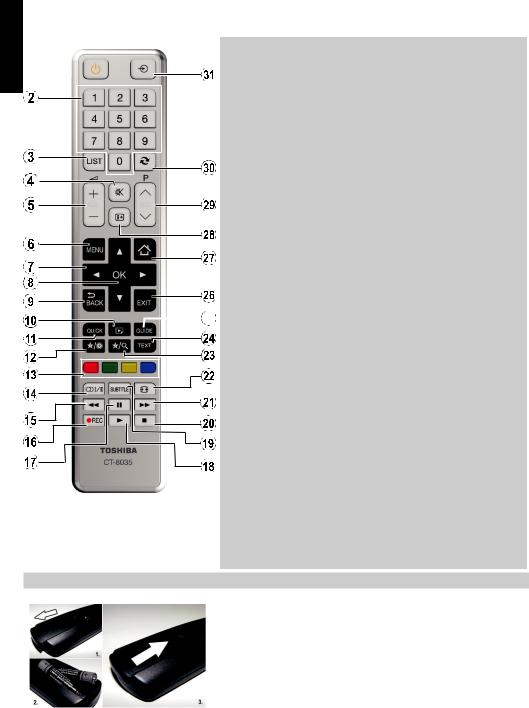

 English
English
The Remote Control
Simple at-a-glance reference of your remote control.
1. Standby
Standby
2. Numeric buttons
Numeric buttons
3. TV-AV / Channel list / Switches among broadcast types
4. Mute
Mute
5. Volume Up / Down
Volume Up / Down
6. Menu on-off
Menu
7. Navigation buttons (Up/Down/Left/Right)
Navigation buttons
8. Okay (Conirm) / Hold (in TXT mode) / Channel List
OK
9. Return / Index page (in TXT mode)
10. Media Browser
Angle
11. Quick Menu

 12. My button 1(*)
12. My button 1(*)
Display time / DVD menu
13. Coloured buttons
Red button - Zoom Green button - Repeat Yellow button - Root Blue button - Title
14. Mono/Stereo - Dual I-II /
Current Language (in DVB channels)
Language selection
15. Rapid reverse
Search forward
(*) MY BUTTON 1 & MY BUTTON 2
16.No function
17.Pause
Pause
18.Play
Play
19.Subtitle on-off (in Media Browser mode and in DVB channels)
Subtitle
20.Stop
Stop
21.Rapid advance
Search forward
22.Image size
Image size
23.My button 2(*)
Search Mode
24.Teletext / Mix (in TXT mode)
25.Electronic programme guide(in DVB channels)
26.Exit
Exit
27.Internet portal
28.Info / Reveal (in TXT mode)
Time
29.Programme Down / Page up -
Programme Up / Page down
30.Previous programme
31.AV / Source selection
Source selection
Note: The references in Bold are for models with and in DVD operation.
These buttons may have default functions depending on the model.
However you can set a special function to these buttons by pressing on them for ive seconds when on a desired source, channel or link. A conirmation message will be displayed on the screen. Now the selected
MY BUTTON is associated with the selected function.
Note that if you perform irst time installation, MY BUTTON 1&2 will return to their default function.
Inserting Batteries and Effective Range of the Remote Control
Remove the back cover to reveal the battery compartment and make sure the batteries are inserted the right way round. Suitable battery types for this remote are AAA, IEC R03 1.5V.
Do not combine a used, old battery with a new one or mix battery types. Remove exhausted batteries immediately to prevent acid from leaking into the battery compartment. Dispose of them in a designated disposal area.
Warning: Batteries must not be exposed to excessive heat such as sunshine, ire or the like.
The performance of the remote control will deteriorate beyond a distance of ive metres or outside an angle of 30 degrees from the IR receiver. If the
operating range becomes reduced the batteries may need replacing.
English - 8 -
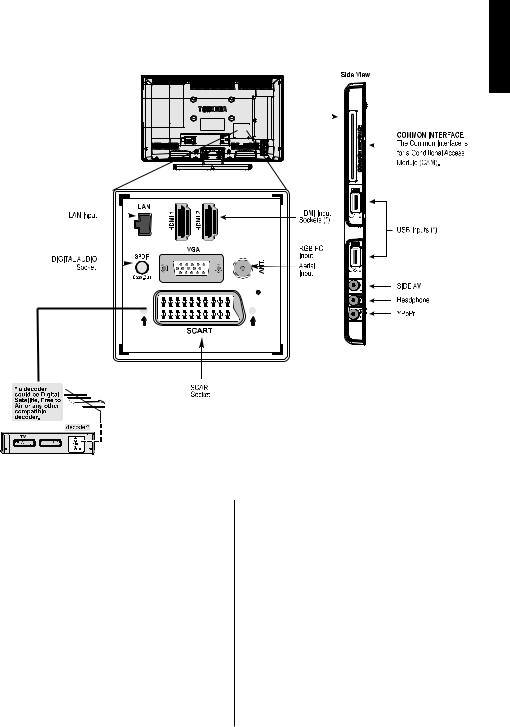
Connecting External Equipment
Before connecting any external equipment, remove the mains plug from the wall socket.
English
(*) Number of these inputs may change according to the model of your TV.
Aerial cable:...........................................................
Connect the aerial to the ANT. socket on the rear of the TV.
SCART lead:..........................................................
If you use a decoder* or a media recorder, it is essential that the scart cable is connected to the TV.
Before running irsttimeinstallation, any connected devices need to be set to standby mode.
The DIGITAL AUDIO socket enables the connection of a suitable surround sound system.
HDMI® (High-Deinition Multimedia Interface) is for using with a DVD decoder or other equipment with digital audio and
video output. It is designed for best performance with 1080i and 1080p high-deinition video signals but will also accept
and display VGA, 480i, 480p, 576i, 576p and 720p signals. PC format signals will also be displayed.
NOTE: Although this TV is able to connect to HDMI equipment, it is possible that some equipment may not operate correctly.
When connecting a device via the Side AV input, you must use the supplied connection cable to enable connection.
When connecting a device via YPbPr input, you must use the supplied connection cable to enable connection.
LAN Input is used to connect the TV to your home network.
A wide variety of external equipment can be connected to the
TV; therefore, the relevant owner’s manuals for all additional equipment must be referred to for exact instructions.
If the TV automatically switches over to monitor external equipment, return to normal TV by pressing the desired programme position button. To recall external equipment, press SOURCE button repeatedly to switch between sources.
Regardless of source’s property, audio output from the DIGI - TAL AUDIO socket cannot be copied.
English - 9 -
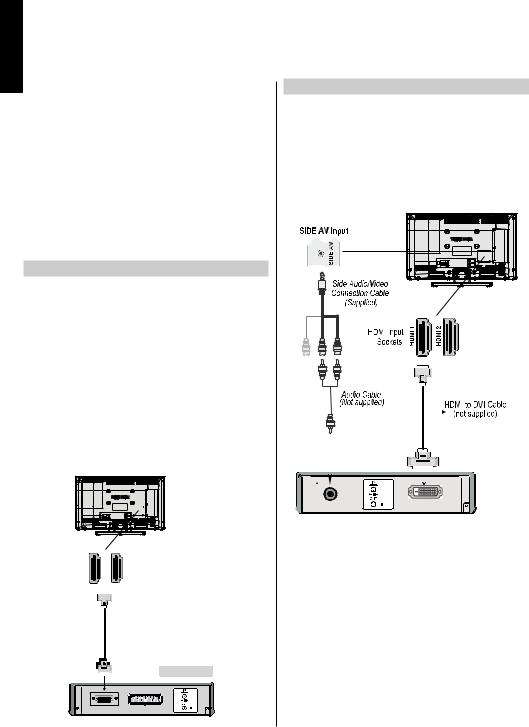
Connecting an HDMI® or DVI Device to the HDMI Input
English
The HDMI inputs on your TV receive digital audio and uncompressed digital video from an HDMI source device or uncompressed digital video from a DVI (Digital Visual Interface) source device.
These inputs are designed to accept HDCP (High-Bandwidth Digital-Content Protection) programme material in digital form from EIA/CEA-861-D–compliant [1] consumer electronic devices (such as a set-top box or DVD player with HDMI or DVI output).
NOTE:
•Some early HDMI equipment may not work properly with your latest HDMI TV.
•Supported Audio format: Linear PCM, sampling rate
32/44.1/48kHz.
To Connect an HDMI Device
Connect an HDMI cable (type A connector) to the HDMI terminal. For proper operation, it is recommended that you use an HDMI cable with the HDMI Logo ( ).
).
•If your HDMI connection is capable of 1080p and/or your TV is capable of refresh rates greater than 50Hz, you will need a Category 2 cable. Conventional HDMI/DVI cable may not work properly with this mode.
•HDMI cable transfers both video and audio. Separate analogue audio cables are not required (see illustration).
•To view the HDMI device video, press SOURCE button to select the appropriate HDMI input.
1MI DH |
2MI DH |
HDMI Input Socket (Back)
To Connect a DVI Device
Connect an HDMI-to-DVI cable (HDMI typeAconnector) to the HDMI input socket and audio cables to the RED and WHITE SIDE AV AUDIO inputs on the Audio/Video connection cable supplied (see illustration).
•The maximum recommended HDMI-to-DVI cable length is 6.6 ft (2m).
•An HDMI-to-DVI cable transfers video only. Separate analogue audio cables are required.
NOTE:
To ensure that the HDMI or DVI device is reset properly, it is recommended that you follow these procedures:
•When turning on your electronic components, turn on the TV irst, and then the HDMI or DVI device.
•When turning off your electronic components, turn off the HDMI or DVI device irst, and then the TV.
HDMI device
English - 10 -

Connecting a Computer |
Connecting a DVD Player |
To Connect a Computer
With either an RGB/PC or an HDMI connection, you can watch your computer’s display on the TV and hear the sound from the TV’s speakers.
When connecting a PC to the RGB/PC input on TV, use an analogue RGB (15-pin) computer cable and use the SIDE
AV socket with a PC audio cable (not supplied) for audio connection, using the supplied Side AV connection cable’s
RED and WHITE inputs (see illustration).
|
|
|
PC VGA |
C ble |
|
|
|
|
(not |
upplied) |
|
|
PC I |
put |
|
|
or |
(ba |
) |
|
|
|
|
|
|
Side |
Audio/Video |
||
|
|
Connection |
C |
ble |
|
|
|
( |
upplied) |
|
|
|
SID |
|
|
|
PC Audio C ble |
SID |
I |
put |
|
|
(not upplied) |
|
|
|
|||
English
Connecting to a DVD Player via YPbPr
Some DVD players are connected through COMPONENT SOCKETS (YPbPr). In this case, you must use the supplied Component YPbPr video
connection cable for enabling connection. First, plug the single jack of the cable to the TV’s YPbPr socket (side). Afterwards, insert your YPbPr cable’s (not
supplied) connectors into the plural part of the supplied YPbPr video connection cable (see illustration below). Colours of the connected jacks should match.
To enable audio connection, use the supplied Side AV connection cable. First, plug single jack of the cable
to the Side AV Input of the TV. Afterwards, insert your
DVD player’s audio cable’s connectors into the plural part of the supplied Side AV connection cable (see illustration below). Colours of the connected jacks should match.
Vide C ecti
To use a PC, set the monitor output resolution on the PC before connecting it to the TV. To display the optimum picture, use the PC setting feature.
NOTE:
•Some PC models cannot be connected to this TV. An adaptor is not needed for computers with a compatible mini D-sub15-pin terminal.
•Depending on the DVD’s title and the speciications of the PC on which you are playing the DVD-Video, some scenes may be skipped or you may not be able to pause during multiangle scenes.
|
|
|
|
|
|
|
|
|
|
|
|
|
|
|
|
|
|
|
PbPr |
|
|
PbPr |
|
|
ideo |
|
|
Co e tio |
|
|
Cable |
|
||
|
|
Cable |
|
( |
ot |
supplied) |
|
|
(supplied) |
|
|
|
|
Audi |
C |
ecti |
|
|
|
|
|
|
|
|
|
|
D D Player |
|
|
|
To |
RED |
& |
WHITE input |
|
Side |
|
|
|
|
|
Side |
I put |
Side |
AV |
Audio |
C ble |
|
|
|
|||||
|
|
Connection |
c ble |
(Not |
|
upplied) |
|
|
( upplied) |
|
|
|
|
Connecting a USB Memory
To Connect a USB Flash Drive
•You can connect a USB Flash Drive to your TV by
using the USB inputs on the TV. This feature allows you to display/play music, photo or video iles stored in a USB stick.
•It is possible that certain types of USB devices (e.g. MP3 Players) may not be compatible with this TV.
•You may back up your iles before making any connections to the TV set in order to avoid any
possible data loss. Note that manufacturer will not be responsible for any ile damage or data loss.
•Do not pull out USB module while playing a ile.
CAUTION: Quickly plugging and unplugging USB devices may cause damage to the USB device.
English - 11 -
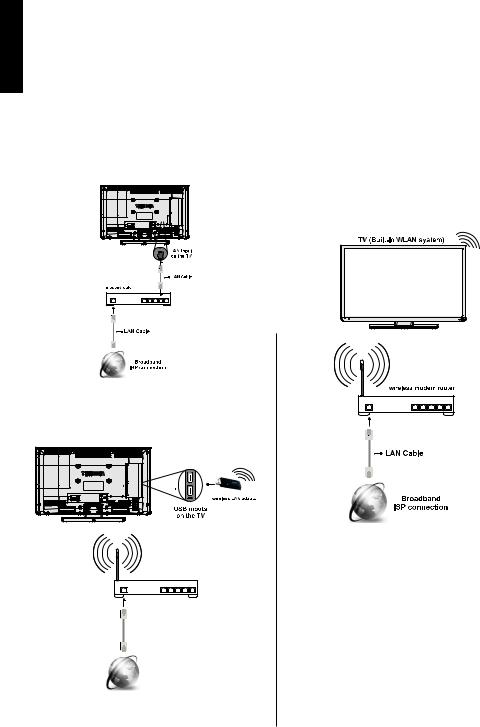
Connecting a home network
English
Connectivity feature allows the TV to connect to the home network wired or wirelessly. You can use this networking system
to connect to the Toshiba Cloud TV Portal or to access photo, video and audio iles that are stored on a MEDIA SERVER
connected to the network and play/display them on the TV.
Wired connection
Connect the TV to the modem/router via a LAN cable (not supplied). Select Network Type as Wired Device in Network Settings menu and press OK to connect.
WirelessconnectionformodelswithoutintegratedWIFI
You need to connect a USB LAN adaptor (sold separately) to one of the USB inputs on your TV to connect to your network wirelessly.
Access point (AP)
wireless modem/router
 LAN Cable
LAN Cable
Note: Wireless USB LAN adaptor can be purchased
from the retail outlet or Toshiba service company. You can ind the phone numbers of the local services on
the back cover of this manual.
Wireless connection for models withintegrated WIFI
To connect the TV to the home network wirelessly just select
Network Type as Wireless Device in Network Settings menu and press OK button. The TV will search for available networks. Select the desired network and press OK. The TV has a built-in WLAN system and has no need for additional devices to connect to a wireless network.
Note: Performance depends on many factors, conditions and
variables, including distance from acces point(AP), volume of network trafic, building materials and construction, operating
system used, mix of wireless products used, interference and other adverse conditions.
Please refer to Network Settings section on page 34 to conigure a wired or a wireless connection.
Broadband ISP connection
English - 12 -
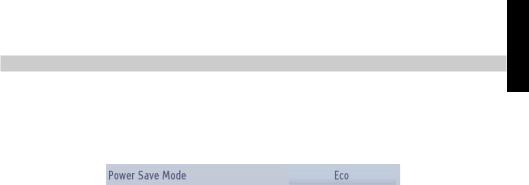
Power Save Mode
Environmental Information
English
This television is designed to be environment friendly. You not only help to save the environment but also you can save money by reducing electricity bills thanks to the energy eficiency feauture of this TV. To reduce energy consumption, you should take the following steps:
You can use Power Save Mode setting, located in the Picture Settings menu. If you set Power Save Mode as Eco, the TV will switch to energy-saving mode and luminance level of TV set will be decreased to optimum level. Note that some picture settings will be unavailable to be changed when the TV is in Power Save Mode.
If pressed Right button, “Screen will be off in 15 seconds.” message will be displayed on the screen. Select
Proceed and press OK to turn the screen off immediately. If you don’t press any button, the screen will be off in 15 seconds. Press any button on the remote or on the TV to turn the screen on again. If you disable Power Save Mode, picture mode will be automatically set to Dynamic.
It is highly recommended to activate Power Save Mode to reduce your annual power consumption. And also it is recommended to disconnect the TV from the mains plug to save more energy when you are not going to use it for a long period of time.
Repair Information
Please refer all servicing to qualiied personnel. Only qualiied personnel must repair the TV. Please contact your local dealer, where you have purchased this TV for further information.
English - 13 -

English
Controlling the TV
A wide variety of external equipment can be connected via the sockets located on the side and back of the TV. Whilst all the necessary adjustments and controls for the TV are made using the remote control, the buttons on the Back of the TV may be used for some functions.
Switching on
If the standby LED is unlit, check that the mains plug is con-
nected to the power and press the  / I button on the back side of the television to switch the television on.
/ I button on the back side of the television to switch the television on.
To put the television into Standby, press  button on the remote control or on the TV. To view the television, press
button on the remote control or on the TV. To view the television, press  button again. The picture may take a few seconds to appear.
button again. The picture may take a few seconds to appear.
Note: The active Standby LED colour will turn to red in a few moments when the TV is switched into Standby.
For energy saving:
Turning the TV off at its mains supply, or un-plugging it, will cut energy use to nearly zero for all TV’s. This is recom-
mended when the TV is not being used for a long time, e.g. when on holiday.
Reducing the brightness of the screen will reduce energy use. Energy eficiency cuts energy consumption and thus
saves money.
NOTE: Putting the TV into standby mode, will reduce energy consumption, but will still draw some power.
Using the Remote Control
Press the MENU button on the remote control to see the menus.
The main menu appears as a group of icons each for a menu option. Press the Left or Right button to select a topic.
In sub menu screen mode the menu appears as a list. Press the Up or Down button to select a topic.
To use the options press the Up and Down buttons on the remote control to move up and down through them and OK, Left or Right buttons to select the required choice. Follow the on screen instructions. The functions of each menu are described in detail throughout the manual.
Using the Controls on the TV
Using the control buttons on the Back of the TV:
•To alter the volume press +  or -
or -  .
.
•To alter the programme position press  P
P  on the Back of the TV.
on the Back of the TV.
•Press +  - buttons at the same to view main menu and use
- buttons at the same to view main menu and use  P
P  to navigate and +
to navigate and +  - to change value.
- to change value.
To select an external input, press  until the appropriate input source is selected.
until the appropriate input source is selected.
Please always refer to the owner’s manual of the equipment to be connected for full details..
English - 14 -
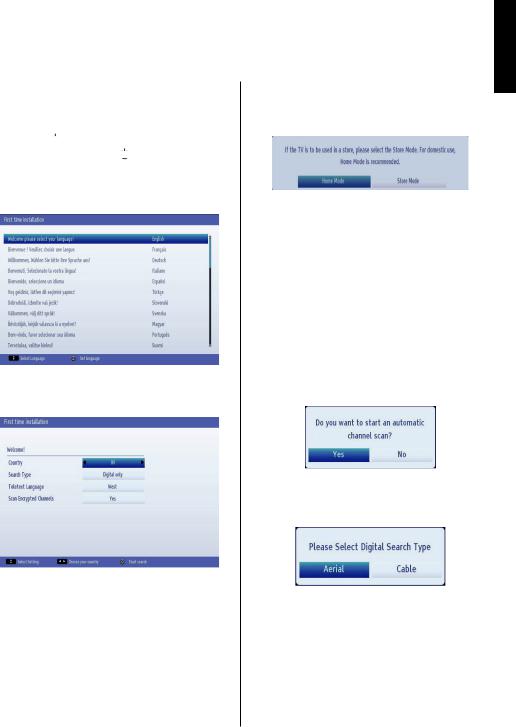
Initial Installation
Before switching on the TV, put your decoder and media recorder to Standby if they are connected and ensure the aerial is connected to your TV. To set up the TV, use the buttons on the remote control as detailed on page 8.
IMPORTANT: Ensure that the aerial is connected and
a Common Interface module is not inserted before switching on the TV for the irst time installation.
1.Connect the mains plug and switch the TV on using the  / I button. If the TV does not switch on, press any numbered or
/ I button. If the TV does not switch on, press any numbered or  button on the remote
button on the remote
control, then the language selection menu will be displayed. This screen will appear the irst time that the TV is switched on and each time the TV is reset.
2.By pressing Up or Down button, highlight the
language you want to set and press OK button.
The following screen will be displayed next:
3.By pressing Left or Right button, select the country you want to set and press Down button to highlight the Search Type option. Use Left or Right to set the desired search type. Available search types are digital only, analogue TV only and full.
4.When set, press Down button to highlight Teletext Language. Use Left or Right button to select desired language region. Highlight Scan Encryted Channels and enable/disable this
option by using Left or Right buttons.
5.Press OK button on the remote control to continue
and the following message will be displayed on the screen:
Select Store mode if the TV will be placed in a store to exhibit. This option will conigure your TV’s settings for best display quality and the supported features of the TV will be displayed on
the top of the screen as a info banner. If Store mode is selected, a conirmation screen will be displayed. Select YES to proceed. This option will be available in Other Settings menu and can be turned off/on later.
If Home Mode is selected, Store Mode will not be available after the First Time Installation. For home use select Home Mode.
6.Press OK button on the remote control to continue
and the following message will be displayed on the screen:
7.Select Yes button by using Left or Right button
and press OK button to continue. Afterwards, the following OSD will be displayed on the screen:
8.If you select Cable option, a conirmation screen
will be displayed. Select YES to proceed. The following screen will be displayed:
Note:Although this cable feature can be selected, it is not fully supported in the UK. If cable signals are input to this TV from a Cable Network Provider some may be displayed.
English
English - 15 -
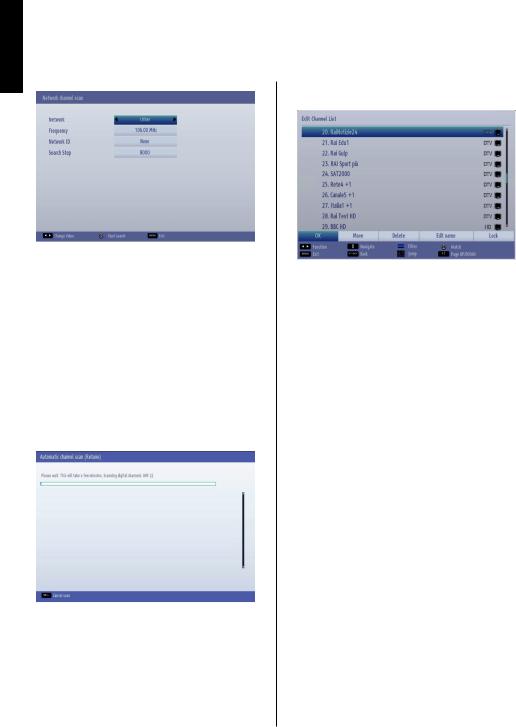
Initial Installation - continued
English
9.You can select Network, Frequency, Network ID and Search Step from this screen. For highlighting lines you see, use Up or Down button. You can set Search Step as 8000 kHz or 1000 kHz. If you select 1000 kHz, the TV will perform search
process in a detailed way. Searching duration will thus increase accordingly. When inished, press
OK button to start automatic search.
10.If you select Aerial option from the Search Type screen, the television will search for broadcasts.
11.The Auto tuning screen will appear and the television will start to search for available stations. The progress bar will move along the line. You must allow the television to complete the search.
Note: You can press MENU button to cancel.
While the search continues a message will appear,
asking whether you want to sort channels according to the LCN(*). Select Yes and press OK to conirm.
(*) LCN is the Logical Channel Number system that organizes available broadcasts in accordance with a recognizable channel sequence (if available).
After the available stations are stored, Edit Channel List will be displayed on the screen.
Press OK button to quit channel list and watch TV.
Note: Do not turn off the TV while initializing irst time installation.
English - 16 -
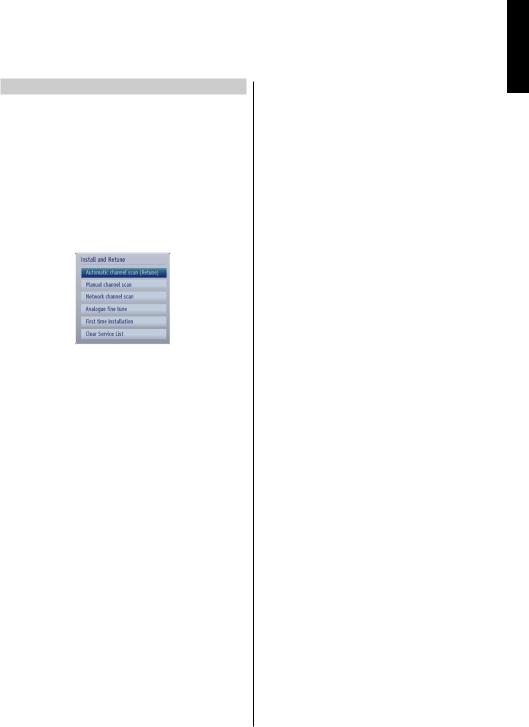
Auto Tuning
Auto Tuning
As new services are broadcast, it will be necessary to retune the television in order to view them.
•It is recommended to run Auto Tuning periodically to ensure that all new services are added. Please be aware that Auto Tuning will completely retune the television and all current channels and settings will be lost.
•Press MENU button on the remote control and select
Install and Retune by using Left or Right button. Press OK button and the following menu screen will be displayed.
•Select Automatic Channel Scan (Retune) by using
Up or Down button and press OK button. Automatic Channel Scan options will be displayed. You can select options by using Up or Down and OK buttons.
Auto Channel Scan Menu Operation
Digital Aerial: Searches and stores aerial DVB stations.
Digital Cable: Searches and stores cable DVB stations.
Analogue: Searches and stores analogue stations.
Digital Aerial & Analogue: Searches and stores aerial DVB and analogue stations.
Digital Cable & Analogue: Searches and stores cable DVB and analogue stations.
Note: Although this cable feature can be selected, it is not fully supported in the UK. If cable signals are input to this TV from a Cable Network Provider some may be displayed.
•Whenever you select an automatic search type and press OK button, a conirmation screen will appear on the screen. To start installation process, select Yes, to cancel select No by using Left or Right and OK button.
•After auto channel scan type is set and selected and conirmed, installation process will start and progress bar will move along. The television will
English
English
search for all available stations. You must allow the television to complete the search. Press MENU button to cancel the process. In such a case, located channels are not stored.
- 17 -
